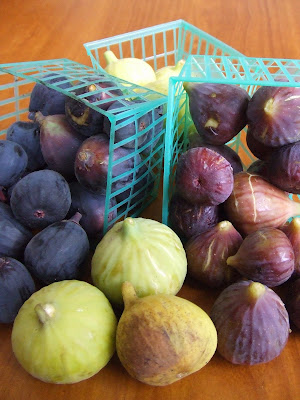
Meet Mr. Fig, more formally knows as Ficus carica. He is a native of Mesopotamia but probably has an ancestor from down south in the Arabian Peninsula. The Fig family has been around for generations--there’s fossil evidence of its existance from as far back as the Neolithic period, around 9400 BC. Food-wise, those Sumerians were probably the first to eat the little guys, around 2900 BC. Those figs like to brag how they were one of the first cultivated fruits. When they start talking about it, just nod your head and think about something else. Later on, the Greeks took members of his family west across the Meditteranean all the way over to Portugal, and by the 8th century AD, some adverturous clansmen crossed all the way to China. The Americas weren’t introduced to these guys until the Spaniards decided to go exploring.

Mr. Fig and his family like dry, warm places. They don’t do well when it’s cold. Weaklings. Thankfully, they are cultivated 2-3 times a year, once in the spring from the previous season’s shoots, and the new (cough, better) stuff grows in late summer/early fall.
They’re very delicate and high maintenance though. That long standing family history makes them think they’re more important than other fruits. They have to be eaten quickly after being picked and don’t transport very well. These are not sturdy workhorses. But as much as they think so highly of themselves, I’ll let you in on a little known secret--those guys aren’t even real fruits! Those posers. Imposters I tell you. They’re actually the flower of the fig tree that is inverted into itself. As a flower, they’re duds.
Even so, they do deserve recognition for being the “fruit” that is mentioned the most in the bible. After eating the forbidden apple, Adam and Eve used fig leaves to cover their newly discovered parts. Romans cherished figs as well, especially considering that Romulus and Remus slept with their wolf mom under a fig tree.
All in all, their snobbery is a little justified. Plus, they’re high in fiber and potassium, and surprisingly have quite a bit of calcium in them. So read below to see what some of the major types are and maybe you’ll find one you like enough to make a member of your fruit family.
Adriatic: One of the more commonly seen light green or yellowish-green in color with pale pink or dark red flesh. Not as sweet as other varieties. They have an intense fig flavor when dried, but can also be eaten fresh.
Brown Turkey: These guys are probably the most commonly seen fresh figs out there. They’re medium sized with a purplish skin with a bright pink flesh. Turkey figs are my friends.

Calimyrna: They’re really called Smyrnas but those grown in the 31st state of the USA get a special name. The members of this side of the family are big, round, and have a thick, light green colored skin. The white and pink flesh inside isn’t as sweet as the rest of the clan, but when you get to know them a little better, letting them dry out, they turn soft and tender.

Celeste: small to medium, violet skin with extremely sweet, white flesh. Good fresh or dried. are about the size of an egg, a purplish-brown when ripe, and a dark, sweet, moist, purple flesh inside.
Kadota: Their claim to faim is that they’re used to make Fig Newtons. Now aren’t they special. Medium in size with a yellow-green skin, they aren’t as sweet as the Adriatic or Mission fig, but this American version of the
Italian Dottato fig has a bright pink center. awww.
Mission: They’re the smallest of the bunch, but with their dark purple colored exterior and their bright red flesh, they’re flavorful and spunky. They turn black when dried, so watch out. Their name comes from the Spanish missionaries who planted them up and down the California coast.

Foods to follow...

No comments:
Post a Comment